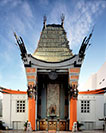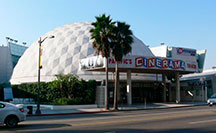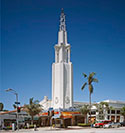California boasts a rich cinematic history, really blossoming in 1912 when major motion-picture companies started moving out west (to avoid motion picture patents, held by Thomas Edison's Motion Picture Patents Company located in New Jersey). Since that fateful migration, Hollywood has become synonymous with the film industry. Downtown Los Angeles, especially, saw the rise (and eventual closure) of many historic palatial movie theaters such as Sid Grauman’s Million Dollar Theater, Stiles O. Clements’ Mayan Theater, and G. Albert Lansburgh’s Orpheum Theater, which are still standing, but have been reinvented as concert venues and nightclubs.
Here at NATO, we’ve compiled a list of must-see movie theater landmarks that give a glimpse inside of California’s more than 100-year-old lucrative career.
| Click images to enlarge: | Click theatre names to visit websites: |
 |
The Arlington Theater - Santa Barbara, CA (http://thearlingtontheatre.com/) Stepping inside this 2,000 seat theater, a moviegoer is instantly transported to another era. Built in the Mission Revival and Spanish Colonial Revival styles in 1931 (after a 1925 earthquake demolished 85% of downtown Santa Barbara), the Arlington is a nod to Santa Barbara’s missionary past. The Arlington feels more like a hacienda courtyard than, well...a movie theater. It’s the oldest and biggest movie theater in Santa Barbara. |
 |
Grauman’s Chinese Theater - Hollywood, CA (http://www.tclchinesetheatres.com/) Built by legendary showman Sid Grauman (who first came up with the iconic idea of putting stars’ footprints into wet cement), the movie theater was just one of many movie theater “palaces” created under his legacy (including Hollywood’s Egyptian Movie Theater). Opened in 1927 with the debut of Cecil B. DeMille’s silent movie “King of Kings,” Grauman’s Chinese Theater is arguably the most famous movie theater in the world. |
 |
Cinerama Dome - Hollywood, CA (https://www.arclightcinemas.com/learn-more/dome-21) It looks like the top half of a gigantic golf ball, the Cinerama Dome’s design was revolutionary when it debuted in 1963 for the premiere of “It's a Mad, Mad, Mad, Mad World.” Constructed in a mere 16 weeks, the theater was built exclusively for the “three projector” format (a widescreen format with three synchronized 35 mm projectors); it has since upgraded to a laser projection system. |
 |
Fox Village Theater - Westwood, C (https://www.regencymovies.com/main.php?theaterId=27) When the klieg lights are turned on (and the sky is lit up), a movie premiere is in-the-works. Officially open for business in 1931, Fox Village Theater has since become the venue-of-choice for most of Hollywood’s movie premieres. Regardless of its star-studded clientele, the most iconic feature of this Spanish Revival building is the 170-foot tower which displays, quite prominently, the art deco “Fox” sign. |
We’ve come a long way since the movie palace archetype, made popular in 1913 when Thomas Lamb designed the first official movie palace for Regent Theater in Harlem, New York. Nowadays the art deco facade is traded in for high-tech state-of-the-art facilities, as evidenced by AMC’s Universal Cinema at Universal CityWalk and Regal L.A. LIVE: A Barco Innovation Center, two noteworthy multiplexes in their own right. What hasn’t changed? The movie theater experience.
